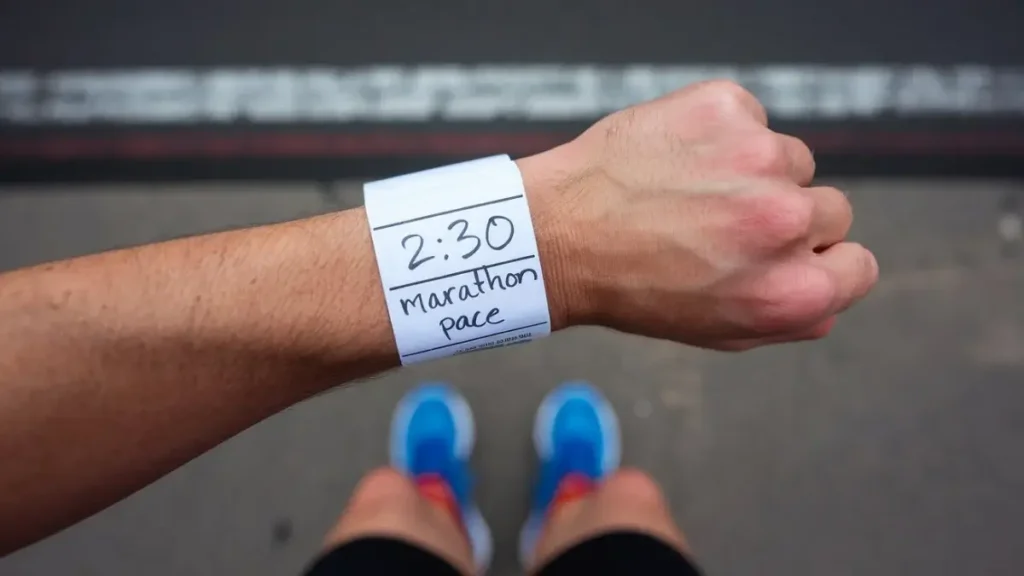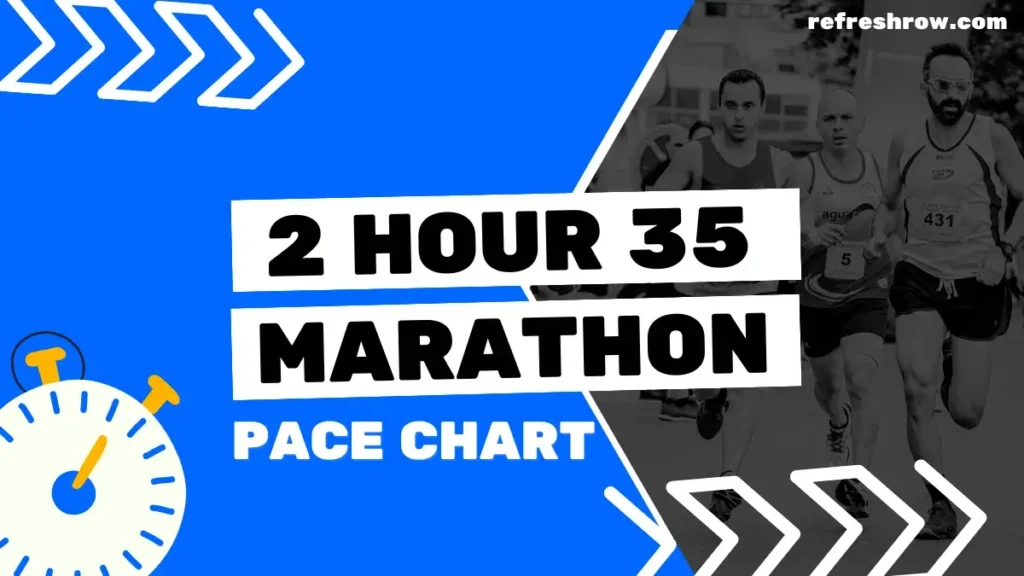To run a 3:40 hour marathon you need to run at a pace of 8:23 per mile or 5:13 per kilometer.
Following the splits below (and shaving off a second), you’ll run a sub 3:40 marathon.
I’d recommend aiming to run 1-2 minutes ahead of the split target time from 10 miles, as you’ll likely come up against crowding on race day.
3:40 Marathon Pace in Miles
| Mile | Split |
|---|---|
| 1 | 8:23 |
| 2 | 16:47 |
| 3 | 25:10 |
| 4 | 33:34 |
| 5 | 41:57 |
| 6 | 50:21 |
| 7 | 58:44 |
| 8 | 1:07:08 |
| 9 | 1:15:31 |
| 10 | 1:23:55 |
| 11 | 1:32:18 |
| 12 | 1:40:41 |
| 13 | 1:49:05 |
| 14 | 1:57:28 |
| 15 | 2:05:52 |
| 16 | 2:14:15 |
| 17 | 2:22:39 |
| 18 | 2:31:02 |
| 19 | 2:39:26 |
| 20 | 2:47:49 |
| 21 | 2:56:13 |
| 22 | 3:04:36 |
| 23 | 3:12:59 |
| 24 | 3:21:23 |
| 25 | 3:29:46 |
| 26 | 3:38:10 |
| 26.2 | 3:40:00 |
Download
3:40 Marathon Pace in KM
| KM | Split |
|---|---|
| 1 | 5:13 |
| 2 | 10:26 |
| 3 | 15:38 |
| 4 | 20:51 |
| 5 | 26:04 |
| 6 | 31:17 |
| 7 | 36:30 |
| 8 | 41:43 |
| 9 | 46:55 |
| 10 | 52:08 |
| 11 | 57:21 |
| 12 | 1:02:34 |
| 13 | 1:07:47 |
| 14 | 1:13:00 |
| 15 | 1:18:12 |
| 16 | 1:23:25 |
| 17 | 1:28:38 |
| 18 | 1:33:51 |
| 19 | 1:39:04 |
| 20 | 1:44:17 |
| 21 | 1:49:29 |
| 22 | 1:54:42 |
| 23 | 1:59:55 |
| 24 | 2:05:08 |
| 25 | 2:10:21 |
| 26 | 2:15:34 |
| 27 | 2:20:46 |
| 28 | 2:25:59 |
| 29 | 2:31:12 |
| 30 | 2:36:25 |
| 31 | 2:41:38 |
| 32 | 2:46:51 |
| 33 | 2:52:03 |
| 34 | 2:57:16 |
| 35 | 3:02:29 |
| 36 | 3:07:42 |
| 37 | 3:12:55 |
| 38 | 3:18:08 |
| 39 | 3:23:20 |
| 40 | 3:28:33 |
| 41 | 3:33:46 |
| 42 | 3:38:59 |
| 42.2 | 3:40:00 |
Download
Other Marathon Pace Charts
Targeting a different time?
Check out the Full Marathon Pace Chart in Miles or KM
Or select a specific finishing time below:
| 3:00 | 4:00 | 5:00 | |
| 3:05 | 4:05 | 5:15 | |
| 3:10 | 4:10 | 5:30 | |
| 3:15 | 4:15 | 5:45 | |
| 3:20 | 4:20 | 6:00 | |
| 3:25 | 4:25 | 6:15 | |
| 2:30 | 3:30 | 4:30 | 6:30 |
| 2:35 | 3:35 | 4:35 | 6:45 |
| 2:40 | 3:40 | 4:40 | 7:00 |
| 2:45 | 3:45 | 4:45 | |
| 2:50 | 3:50 | 4:50 | |
| 2:55 | 3:55 | 4:55 |
Training for a 3:40 Marathon
Is 3:40 a Good Marathon Time?
Well, what do the stats say?
Run Repeat conducted a study that contains 19,614,975 marathon results from more than 32,335 races across the globe, here is how a 3:40 marathon compares against age and gender for the races recorded:
| Overall | You’re faster than 86.0% of all runners. |
| Male | You’re faster than 80.1% of males. |
| Female | You’re faster than 93.9% of females. |
| <20 | You’re faster than 82.1% of under 20s. |
| 20-29 | You’re faster than 81.5% of 20-29 year olds. |
| 30-39 | You’re faster than 82.3% of 30-39 year olds. |
| 40-49 | You’re faster than 85.8% of 40-49 year olds. |
| 50-59 | You’re faster than 92.2% of 50-59 year olds. |
| >60 | You’re faster than 97.7% of over 60s. |
Training Runs and Paces for a 3:40 Marathon
To break a 3:40 marathon you’ll need to do some serious distance in your training, I recommend at least 35 miles (56km) per week.
You’re also going to need to make sure you’ve crossed off these milestones for other race distances:
- A 5k in 22:55 mins
- A 10k in 47:40 mins
- A half marathon in 1 hour 39 mins
Training Paces
| Pace | Mins per Mile | Mins per KM |
|---|---|---|
| Easy | 9:27 | 5:52 |
| Steady | 8:23 | 5:12 |
| 10k | 7:41 | 4:46 |
| 5k | 7:23 | 4:35 |
| 1 Mile | 6:51 | 4:17 |
Weekly Mileage Targets
| Target Mileage: | Gradually increase your weekly mileage from 40 miles (64 km) to a peak of 68 miles (109 km). |
| Incremental Increase: | Increase mileage by approximately 10% each week, with every fourth week as a recovery week where mileage is reduced by 20-30%. Make sure to taper for the last 1-2 weeks. |
Long Run Structure
| Total Distance: | Build up to long runs of 20-22 miles (32-35 km). |
| Segment Example: | First 5 miles (8 km): Easy pace, heart rate 140-150 bpm (approximately 9:45/mile or 6:03/km). Next 1 mile (1.6 km): Fast pace at 7:10/mile (4:27/km). Next 5 miles (8 km): Medium effort, heart rate around 160 bpm (approximately 8:10/mile or 5:04/km). Repeat: Repeat the segment twice (5 miles easy, 1 mile fast, 5 miles medium), you can taper the final 2 miles if required. |
Why This Works: Incorporating varied paces within long runs enhances lactate tolerance, which helps on race day when you’ve got to maintain pace despite feeling fatigued. By practicing surges during a run, you can build up your physical and mental resilience (lots of elite marathon runners use these strategies during their training)
Alternating Long Runs: Alternate between structured long runs (easy/fast segments) and easier long runs. For easier long runs, maintain a steady, comfortable pace throughout, focusing on mileage rather than speed to aid recovery.
Speedwork Sessions
| Short Intervals: | – 800m repeats at 3:35 per interval (4:28/km). – Aim for 6-12 repetitions with equal time for recovery. |
| Mile Repeats: | – 1 mile repeats at 7:10 per mile (4:27/km). – Aim for 6-12 repetitions with a 1-2 minute recovery jog. |
| Longer Intervals: | – 2 mile repeats at 7:20 per mile (4:34/km). – Aim for 5-8 repetitions with a 2-3 minute recovery jog. |
Recovery and Rest Days
| Rest Days: | You don’t need to incorporate rest days if you are using recovery runs, but I recommend taking 1 (or a max of 2) per week to allow your body to recover and prevent overtraining. |
| Easy Run Days: | Include 1-2 easy run days per week at a relaxed pace of 10:00/mile (6:12/km), covering 5-10 miles (8-16 km) per day. Try to keep your heart rate below 140 bpm on easy days to ensure proper recovery and aerobic development. |
My Tips to Run a Sub 3:40 Marathon
Focus on Quality Sleep
One aspect of marathon training that’s often overlooked is the importance of sleep.
I made a conscious effort to improve my sleep quality and quantity and aimed for at least 7-8 hours a night.
I established a bedtime routine that included turning off screens an hour before bed, reading a book, and doing some light stretching.
Good sleep is essential for recovery, muscle repair, and mental clarity.
Prioritize your sleep just as you would your long runs and speed workouts – it’s the foundation that supports all your hard training efforts.
Dial in your Nutrition
Another critical element I fine-tuned for my 3:40 marathon was my nutrition strategy.
It’s not just about carb-loading the night before; it’s about consistent, balanced fueling throughout your training.
I started experimenting with different types of fuel during my long runs – gels, chews, even real food like bananas – to see what my stomach could handle and what gave me the best energy.
On race day, I had a solid plan in place, knowing exactly what and when to eat.
I recommend keeping a journal of what you consume and how it makes you feel, then use this data to perfect your marathon nutrition.
Find a Buddy
Training for a marathon can get quite lonely, but it doesn’t have to be.
Joining a running group or finding a running buddy can provide the support and motivation you need.
I joined a local running club during my 3:40 marathon training, and it was one of the best decisions I made.
Running with others kept me accountable, provided a sense of community, and made long runs more enjoyable.
Plus, you can learn from the experiences of fellow runners and share tips and encouragement along the way.
If a group isn’t your thing, even having one reliable running partner can make a huge difference.
Hill Training
Don’t underestimate the power of hill training in your marathon preparation.
Incorporating hill workouts into your routine can significantly improve your strength and endurance.
Find a hilly route or use a treadmill with an incline setting to challenge yourself.
When I started doing hill repeats, I noticed a marked improvement in my overall running performance.
Hills not only build muscle strength but also enhance your cardiovascular fitness and mental toughness.
Plus, they can break up the monotony of flat routes, making your training more engaging.


Row Brown is the founder of Refresh Row. He is a keen marathon runner, his favorite being the London Marathon. He’s now set himself the mission of Running the Entire Length of Spain, which is scheduled for late 2024.


